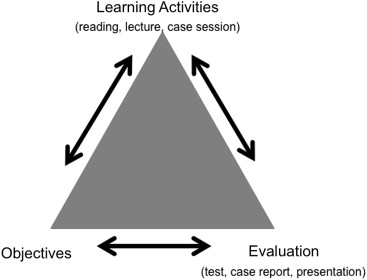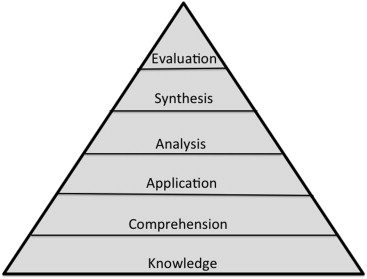Learning objectives are a critical step in the creation and implementation of a radiology curriculum. Their use is mandated by the Liaison Committee on Medical Education, the Accreditation Council on Graduate Medical Education, and the Accreditation Council on Continuing Medical Education, but more importantly they can have a significant beneficial impact on quality of radiology education programs. Learning objectives guide student learning, help clarify our teaching goals, and simplify learner testing and evaluation. This article will review the components of a proper learning objective and provide a simple, straightforward approach to writing them effectively.
A learning objective is a statement that describes in specific terms what knowledge, skills, or attitudes learners should be able to demonstrate following instruction. They aren’t simply a “table of contents” style list of topics that will be addressed or a list of teaching goals for a session or course. Rather, a learning objective should outline what students will be able to do that they couldn’t do before the teaching exercise. Fundamentally, learning objectives should target the essential take home points of a course.
The creation of learning objectives is often an undervalued step in medical curriculum planning, in part because as teachers we are often accustomed to focusing on our goals. Although it is useful to communicate what we as educators want to accomplish, in the form of a list of topics to be covered or “goals” for a session, this is not a substitute for learning objectives. Fundamentally, a learning objective is written with the intent of learning rather than teaching as the goal. Learning objectives communicate what the learner should be able to do as a result of the teaching session or curriculum. In other words, they are outcomes-based and learner-centered.
Learning objectives have been used in different areas of education for many years, more so after being popularized by Robert Mager in his text Preparing Instructional Objectives in 1962 . However, their integration into medical education, at least at a postgraduate level, is more recent, coinciding to a degree with the Accreditation Council on Graduate Medical Education (ACGME) guidelines for competency-based education . Among academic radiologists and undoubtedly physician educators in many fields, confusion still exists as to the correct use and utility of learning objectives. This article will review the components of a proper learning objective and provide a simple, straightforward approach to writing them effectively.
Administrative oversight: The requirements
Whether pertaining to undergraduate medical curricula, radiology residency programs, or continuing medical education activities, learning objectives are now a required component in medical curricular planning.
Undergraduate Medical Education
The Liaison Committee on Medical Education (LCME) has been the accrediting authority for US medical schools since 1942 and now has multiple requirements for the use of learning objectives in the undergraduate medical realm. Specifically, an educational program requirement (ED-1) states: “The faculty of an institution that offers a medical education program must define the objectives of its program. The objectives must serve as guides for establishing curriculum content and provide the basis for evaluating the effectiveness of the program” .
Graduate Medical Education
Get Radiology Tree app to read full this article<
Continuing Medical Education
Get Radiology Tree app to read full this article<
Get Radiology Tree app to read full this article<
The utility of learning objectives
Get Radiology Tree app to read full this article<
Get Radiology Tree app to read full this article<
Get Radiology Tree app to read full this article<
The components of a proper learning objective
Get Radiology Tree app to read full this article<
Get Radiology Tree app to read full this article<
Get Radiology Tree app to read full this article<
Get Radiology Tree app to read full this article<
Get Radiology Tree app to read full this article<
Table 1
Bloom’s Taxonomy of Educational Objectives
Competence Skills Demonstrated Question Cues Cognitive Domain Knowledge Remembering of terminology, facts, and methods Define
Describe
Identify
Show
Label Examine
Tabulate
Name
Write
Quote Comprehension Understand the meaning of conceptual information; translate knowledge into new context; interpret facts; predict consequences Summarize
Describe
Interpret
Contrast
Predict
Associate Distinguish
Estimate
Differentiate
Discuss
Extend Application Use previously learned information in novel situations; solve problems Apply
Demonstrate
Calculate
Complete Solve
Examine
Modify
Classify Analysis Understand the organizational structure of information; see patterns; organize parts Analyze
Separate
Order
Connect
Arrange Divide
Compare
Select
Infer Synthesis Creative application of prior knowledge and skills to produce an original entity Adapt
Create
Combine
Integrate
Modify Generate
Design
Invent
Compose
Formulate Evaluation Judge relative value of information based on prior knowledge; make choices based on reasoned argument; recognize subjectivity Compare and contrast
Criticize
Critique
Defend
Judge Affective Domain Attitudinal Demonstrating or adopting attitude change Consider
Exemplify
Modify
Plan Rank as important
Realize
Reflect
Revise Psychomotor Domain Performance or behavior Skills associated with performing laboratory techniques, record-, physical examination, etc. Calibrate
Demonstrate
Diagnose
Diagram
Listen/hear Measure
Operate
Perform
Record
Write
Get Radiology Tree app to read full this article<
Writing learning objectives: A guide
Get Radiology Tree app to read full this article<
Get Radiology Tree app to read full this article<
Get Radiology Tree app to read full this article<
Incorrect Learning Objective Format
Get Radiology Tree app to read full this article<
Get Radiology Tree app to read full this article<
Get Radiology Tree app to read full this article<
Correct Learning Objective Format
Get Radiology Tree app to read full this article<
Get Radiology Tree app to read full this article<
Get Radiology Tree app to read full this article<
Get Radiology Tree app to read full this article<
Get Radiology Tree app to read full this article<
Get Radiology Tree app to read full this article<
Get Radiology Tree app to read full this article<
Get Radiology Tree app to read full this article<
Get Radiology Tree app to read full this article<
Get Radiology Tree app to read full this article<
Incorrect Learning Objective Format
Get Radiology Tree app to read full this article<
Get Radiology Tree app to read full this article<
Get Radiology Tree app to read full this article<
Correct Learning Objective Format
Get Radiology Tree app to read full this article<
Get Radiology Tree app to read full this article<
Get Radiology Tree app to read full this article<
Ranking objectives in bloom’s taxonomy
Get Radiology Tree app to read full this article<
Get Radiology Tree app to read full this article<
Table 2
Learning Objectives Ranked to Levels of Bloom’s Cognitive Domain
Bloom’s Level Competence Example of Learning Objective 1 KnowledgeQuote risks associated with radiation exposure 2 ComprehensionDiscuss the role of abdominal ultrasound in the assessment of an acute trauma patient 3 ApplicationApply proper terminology when describing a fracture 4 AnalysisAnalyze the bowel gas pattern on an abdominal plain film 5 SynthesisCompose an appropriate imaging algorithm for a patient with shortness of breath 6 EvaluationCompare and contrast the role of computed tomography versus magnetic resonance in the diagnosis of adrenal adenomas
Get Radiology Tree app to read full this article<
Achievement of objectives
Get Radiology Tree app to read full this article<
Table 3
Benefits of Learning Objectives for Both Learners and Educators
Benefits of Learning Objectives Allow communication with others about the content and intent of a teaching activity Clarify and help direct teaching goals Ensure that educational methods (eg, lecture, small group discussion) are properly aligned with the goals of the session Help focus studying by ensuring that students concentrate on what is essential Provide a check as to whether a curriculum teaches at multiple cognitive levels as outlined in Bloom’s taxonomy Simplify assessment: Assessment questions should match the content and Bloom’s level of the relevant learning objectives Give students a clear idea of what is expected of them Give students a better platform to evaluate our performance as educators
Get Radiology Tree app to read full this article<
Get Radiology Tree app to read full this article<
Get Radiology Tree app to read full this article<
Summary
Get Radiology Tree app to read full this article<
Get Radiology Tree app to read full this article<
References
1. Mager R.F.: Preparing instructional objectives.1962.Fearon PublishersBelmont, CA
2. Accreditation Council for Graduate Medical Education. Outcomes Project: Project Home and General Competencies, 2001 – revised 2008. Available at: http://www.acgme.org/acgmeweb/ . Accessed May 1, 2012.
3. Liaison Committee on Medical Education Accreditation Standards, May 2011 version. Available at: http://www.lcme.org/start.htm . Accessed April 24, 2012.
4. ACGME Program Requirements for Graduate Medical Education in Diagnostic Radiology, 2008. Available at: http://www.acgme.org/acgmeweb/tabid/148/ProgramandInstitutionalGuidelines/Hospital-BasedAccreditation/DiagnosticRadiology.aspx . Accessed May 3, 2012.
5. ACCME Criteria Toolkit. Available at: https://www.cme.ucsf.edu/planners.aspx . Accessed May 2, 2012.
6. Writing Learning Objectives. Available at: http://it.stonybrook.edu/help/kb/learning-objectives . Accessed May 7, 2012.
7. Bloom B.S.: Taxonomy of educational objectives: cognitive domain.1984.LongmanNew York
8. Krathwohl D.R.: A revision of bloom’s taxonomy: an overview. Theory into Practice 2002; 41: pp. 212-218.
9. Anderson L., Krathwohl D.A.: Taxonomy for learning, teaching and assessing: a revision of bloom’s taxonomy of educational objectives.2001.LongmanNew York
10. Goodhart F, Verdi P, Kennedy S. Assuring quality in health education, 1991 with contributions by Peter Ronner, PhD, Thomas Jefferson University, 2011, Tracy Fulton PhD and Christy Boscardin PhD. University of California, San Francisco, 2011.
11. Kern D.E., Thomas P.A., Howard D.M., et. al.: Curriculum development for medical education: a six-step approach.1998.Johns Hopkins University PressBaltimore, MD
12. Alderson P.O., Becker G.J.: The new requirements and testing for American Board of Radiology certification in diagnostic radiology. Radiology 2008; 248: pp. 707-709.
13. Bridge P.D., Musial J., Frank R., et. al.: Measurement practices: methods for developing content-valid student examinations. Med Teach 2003; 25: pp. 414-421.

